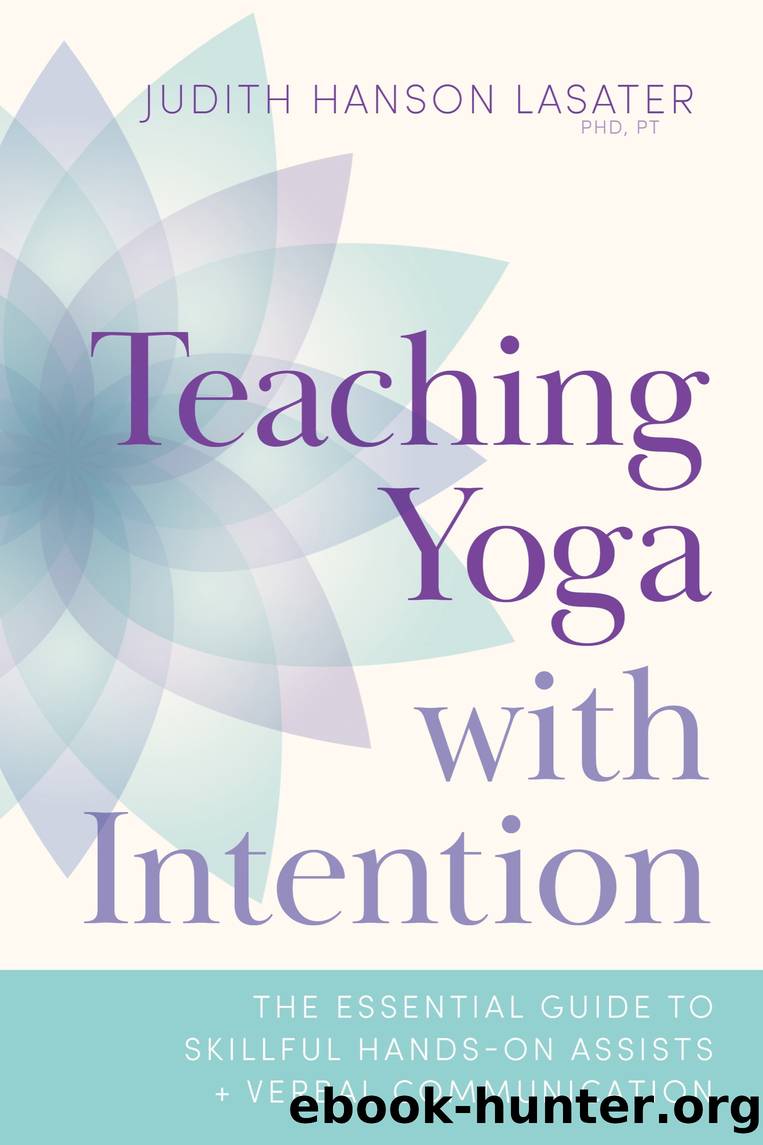Teaching Yoga with Intention by Judith Hanson Lasater

Author:Judith Hanson Lasater [Lasater, Judith Hanson]
Language: eng
Format: epub
Publisher: Shambhala
Published: 2021-10-12T00:00:00+00:00
When to Touch, When Not To
When we teach a yoga class, there could be anywhere from ten to one hundred or more students in the room. Clearly in these large classes, we cannot touch everyone in every class, and I think not only is that not possible, it is not advisable. How do we ascertain when to touch a student?
There are a number of reasons to touch. First among them is to touch for safety. If I see a student doing something that I consider dangerous in the short term, or possibly injurious in the long term, I would be moved to touch them to help show them another way to be in the pose. My intention would be to quickly offer new information to the student with my words and touch in order to protect them.
Another reason to touch is to enhance the studentâs experience of the pose. If I see strain or struggle, I might touch to bring the student back from being so deeply into the pose and to remind them of this important principle: alignment before range. In other words, first follow basic alignment principles in the pose, and then attempt to slowly and gently go deeper. I want the student to focus more on alignment because I believe it is safer, and eventually the deeper range of the movement will come, and likely with it, no injury.
For the most experienced students, I often touch lightly to help them do less in the pose. Often experienced students have simply gotten into a rut of overdoing, overstretching, and overreaching in the pose. This can cause injury, of course, but doing the pose the same way every time is simply creating a habit, it is not being present with the pose. One often will see experienced students practice the asana from memory, in other words, just do âyesterdayâsâ pose by going quickly and as deeply as possible into the pose, then immediately stop and hold. This way of practicing is from habit, not awareness.
Sometimes I find that touching the experienced student to encourage them to do less is ironically the hardest thing I could possibly ask them to do. I personally understand the urge to push further and further into the poses every day. However, I also personally understand that too much flexibility can be a problem. If we do the pose in the same way every day, we are not learning anything new, and we could be setting ourselves up for future injury due to hypermobility. Hypermobile joints lack stability and thus put strain on other tissues like ligaments, tendons, and muscles. Practicing with pristine alignment in the poses will help protect those students who are born with hypermobile joints.
While it sounds like a great idea at first blush, I do not hold to the dictum that yoga teachers should âtouch every student in every class.â Practically this is simply not possible because of the sheer number of students in some classes and the limited time allowed for the class.
Download
This site does not store any files on its server. We only index and link to content provided by other sites. Please contact the content providers to delete copyright contents if any and email us, we'll remove relevant links or contents immediately.
Bodyweight Strength Training by Jay Cardiello(7185)
Tools of Titans by Timothy Ferriss(6946)
Born to Run: by Christopher McDougall(6260)
Inner Engineering: A Yogi's Guide to Joy by Sadhguru(5896)
Asking the Right Questions: A Guide to Critical Thinking by M. Neil Browne & Stuart M. Keeley(4574)
The Fat Loss Plan by Joe Wicks(4239)
Bodyweight Strength Training Anatomy by Bret Contreras(4059)
Yoga Anatomy by Kaminoff Leslie(3701)
Science and Development of Muscle Hypertrophy by Brad Schoenfeld(3578)
Dynamic Alignment Through Imagery by Eric Franklin(3489)
The Four-Pack Revolution by Chael Sonnen & Ryan Parsons(3484)
ACSM's Complete Guide to Fitness & Health by ACSM(3468)
Yoga Anatomy by Leslie Kaminoff & Amy Matthews(3395)
Bodyweight Strength Training: 12 Weeks to Build Muscle and Burn Fat by Jay Cardiello(3350)
The Ultimate Bodybuilding Cookbook by Kendall Lou Schmidt(3319)
Exercise Technique Manual for Resistance Training by National Strength & Conditioning Association(3291)
Nutrition for Sport, Exercise, and Health by Spano Marie & Kruskall Laura & Thomas D. Travis(3234)
Nutrition for Sport, Exercise, and Health by Marie Spano & Laura Kruskall & D. Travis Thomas(3232)
Yoga Therapy by Mark Stephens(3222)
